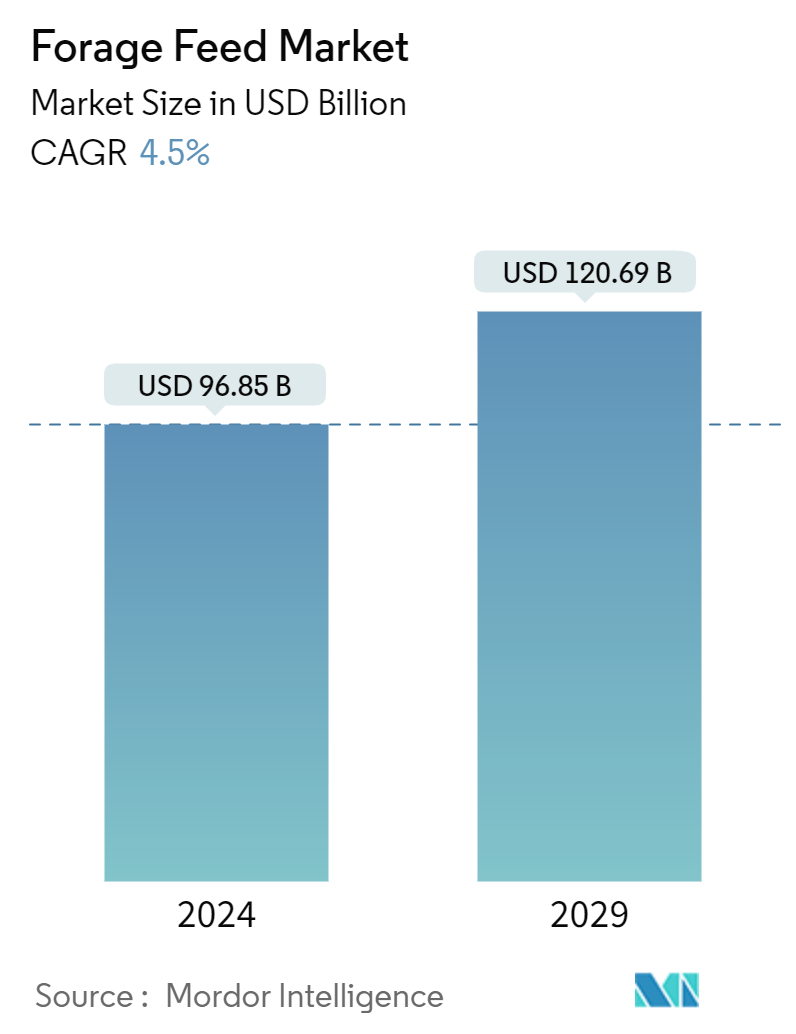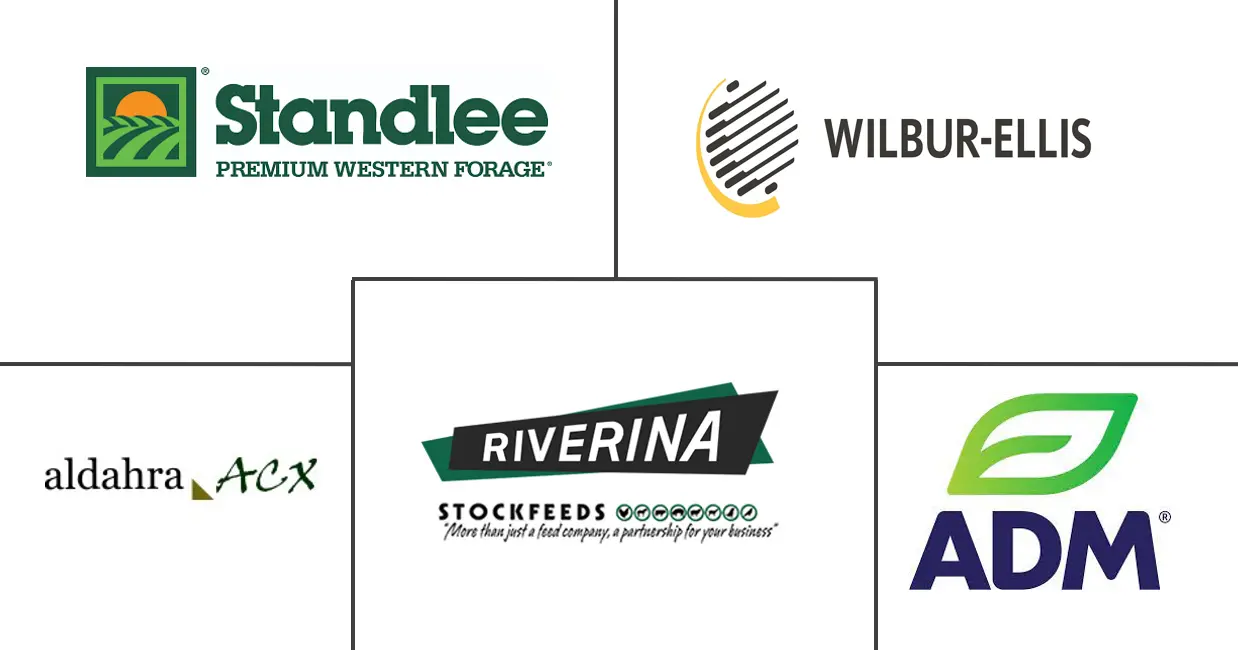Market Size of Forage Feed Industry

| Study Period | 2019 - 2029 |
| Market Size (2024) | USD 96.85 Billion |
| Market Size (2029) | USD 120.69 Billion |
| CAGR (2024 - 2029) | 4.50 % |
| Fastest Growing Market | Asia Pacific |
| Largest Market | North America |
Major Players
*Disclaimer: Major Players sorted in no particular order |
Forage Feed Market Analysis
The Forage Feed Market size is estimated at USD 96.85 billion in 2024, and is expected to reach USD 120.69 billion by 2029, growing at a CAGR of 4.5% during the forecast period (2024-2029).
- Forage plays a significant role in the agriculture sector by improving crop diversity, wildlife habitat, and soil ecosystem. If the proper crop is selected and carefully managed, forage feed can be a valuable tool for growers as they are highly nutritious and productive.
- The increased number of livestock is anticipated to support the growth of the market studied. For instance, as per FAOSTAT, the number of swine in stock across the world stood at 978.7 million in 2021, which increased to 979.0 million in 2022. This increase in the number is expected to boost the consumption of forage feed, as farm animals receive calories, fiber, and necessary protein from it
- Furthermore, various research and development activities and experiments are being undertaken to improve the overall efficiency and intake of forage feed. For instance, to assess the effects of sulfur on forage feed, ICL conducted a series of product experiments in December 2022 comparing mineral fertilizer polysulfate to standard farm practice nitrogen/sulfur products. ICL found that the polysulfate-treated strips produced, on average, an 11.24% increase in dry matter compared to the standard farm practice. Also, polysulfate-treated grass contained, on average, 9.72% more sugars, making it more palatable to livestock.
- Moreover, with the growing demand for forage feed supplies in the livestock industry, authorities are taking initiatives that are anticipated to pave the way for future market growth. For instance, in 2022, DeLaval launched a new version of its OptiDuo feed-pushing robot, claiming the new model can add up to three liters of milk per cow daily. The OptiDuo remixes forage to make it more palatable and reduce waste. A twin-spiralled rotating auger and adaptive drive function enable a variety of forage types to be mixed and made available to cows 24 hours a day.
- Therefore, with factors such as growth in livestock stocks, increasing research and development, and technological innovation, the market studied is anticipated to grow over the coming years.
Forage Feed Industry Segmentation
Forage feed consists of crops that can be fed directly to livestock or slightly processed by partial drying or pre-digestion.
The report covers an extensive study of segments and factors driving the growth of the commercial forage feed market. The forage feed market is segmented by products (stored forage, fresh forage, and other products), animal type (ruminants, poultry, swine, and other animal types), and geography (North America, Europe, Asia-Pacific, South America, and Middle East and Africa). The report offers the market estimation and forecast for the market in value (USD) for the above-mentioned segments.
| Products | |
| Stored Forage | |
| Fresh Forage | |
| Other Products |
| Animal Type | |
| Ruminants | |
| Poultry | |
| Swine | |
| Other Animal Types |
| Geography | ||||||||
| ||||||||
| ||||||||
| ||||||||
| ||||||||
|
Forage Feed Market Size Summary
The forage feed market is poised for significant growth, driven by the increasing demand for livestock products and the essential role of forage in enhancing crop diversity and soil health. As livestock numbers rise globally, the consumption of forage feed is expected to increase, providing necessary nutrients like calories, fiber, and protein to farm animals. This growth is further supported by ongoing research and technological advancements aimed at improving forage feed efficiency and palatability. Innovations such as the development of feed-pushing robots and experiments with mineral fertilizers are contributing to the market's expansion. The demand for high-quality animal products is pushing farmers towards selecting superior forage crops, thereby bolstering the market.
North America stands out as a key region in the forage feed market, supported by its robust agricultural industry and technological advancements in farming. The region's favorable climatic conditions and substantial arable land facilitate the growth of various forage crops, making it a significant player in the global market. The United States and Canada, with their extensive dairy and beef production, not only meet domestic needs but also export high-quality products worldwide. Regulatory policies and initiatives, such as the modification of the Annual Forage Insurance Program, are expected to further support market growth. The fragmented market landscape, with key players engaging in strategic activities like mergers and new product launches, indicates a competitive environment aimed at expanding market share and catering to a broader consumer base.
Forage Feed Market Size - Table of Contents
-
1. MARKET DYNAMICS
-
1.1 Market Overview
-
1.2 Market Drivers
-
1.2.1 Growing Livestock Population
-
1.2.2 Area Under Forage Production is Increasing
-
1.2.3 Increasing Demand for Animal Products
-
-
1.3 Market Restraints
-
1.3.1 Competition Amongst Industries and High Input Prices
-
1.3.2 Growing Shift Toward Vegan-Based Diet
-
-
1.4 Porter's Five Forces Analysis
-
1.4.1 Threat of New Entrants
-
1.4.2 Bargaining Power of Buyers/Consumers
-
1.4.3 Bargaining Power of Suppliers
-
1.4.4 Threat of Substitute Products
-
1.4.5 Intensity of Competitive Rivalry
-
-
-
2. MARKET SEGMENTATION
-
2.1 Products
-
2.1.1 Stored Forage
-
2.1.2 Fresh Forage
-
2.1.3 Other Products
-
-
2.2 Animal Type
-
2.2.1 Ruminants
-
2.2.2 Poultry
-
2.2.3 Swine
-
2.2.4 Other Animal Types
-
-
2.3 Geography
-
2.3.1 North America
-
2.3.1.1 United States
-
2.3.1.2 Canada
-
2.3.1.3 Mexico
-
2.3.1.4 Rest of North America
-
-
2.3.2 Europe
-
2.3.2.1 Germany
-
2.3.2.2 United Kingdom
-
2.3.2.3 France
-
2.3.2.4 Russia
-
2.3.2.5 Spain
-
2.3.2.6 Rest of Europe
-
-
2.3.3 Asia-Pacific
-
2.3.3.1 China
-
2.3.3.2 Japan
-
2.3.3.3 India
-
2.3.3.4 South Korea
-
2.3.3.5 Rest of Asia-Pacific
-
-
2.3.4 South America
-
2.3.4.1 Brazil
-
2.3.4.2 Argentina
-
2.3.4.3 Rest of South America
-
-
2.3.5 Middle East and Africa
-
2.3.5.1 United Arab Emirates
-
2.3.5.2 Saudi Arabia
-
2.3.5.3 South Africa
-
2.3.5.4 Egypt
-
2.3.5.5 Rest of Middle East and Africa
-
-
-
Forage Feed Market Size FAQs
How big is the Forage Feed Market?
The Forage Feed Market size is expected to reach USD 96.85 billion in 2024 and grow at a CAGR of 4.5% to reach USD 120.69 billion by 2029.
What is the current Forage Feed Market size?
In 2024, the Forage Feed Market size is expected to reach USD 96.85 billion.

